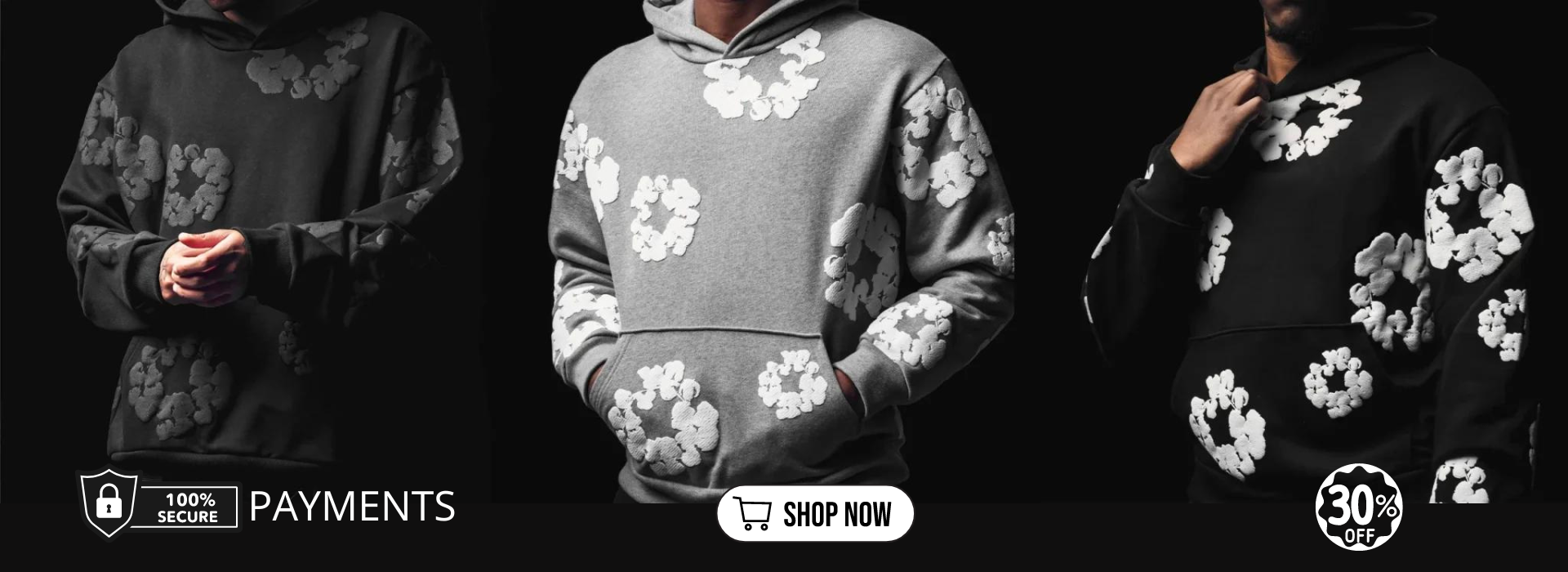
The Rise of Denim Tears Canada: Culture, Style, and Identity
In recent years, the fashion landscape has witnessed an evolution that extends far beyond seasonal trends and commercial cycles. Among the most thought-provoking and culturally rich brands shaping this transformation is Denim Tears. Known for its unapologetic storytelling, <a href="https://denimtears.ca/">denim tears</a> bold visuals, and deep connection to Black history, Denim Tears has carved a unique space in global fashion. Its growing influence in Canada represents not only a shift in style but also a deeper dialogue about identity, cultural awareness, and the power of expression through clothing.
The Origins of Denim Tears: A Cultural Movement
Denim Tears was founded by Tremaine Emory, a visionary designer whose work transcends the boundaries of fashion. Emory, who has collaborated with leading brands such as Supreme, Stüssy, and Levi’s, created Denim Tears as a vehicle to tell the story of the African diaspora—particularly the pain, resilience, and creativity that define it. The brand’s designs often feature symbols like cotton wreaths, a powerful reminder of slavery’s legacy and the enduring strength of Black identity.
For Emory, Denim Tears is more than a brand; it is a cultural movement. Every collection is an act of remembrance and resistance, challenging the industry to acknowledge its historical blind spots while celebrating Black culture as a foundational influence in global style. What makes Denim Tears exceptional is its ability to blend cultural commentary with commercial appeal—a rare combination that has resonated across borders, including in Canada.
The Canadian Connection: More Than Fashion
Canada’s fashion scene has always been defined by diversity and multiculturalism. From Toronto’s bustling streetwear hubs to Montreal’s avant-garde fashion houses, Canadian style thrives on cultural fusion. The arrival and rise of Denim Tears in this landscape feels not only natural but necessary. Canadian consumers, especially younger generations, have shown a growing appetite for brands that embody authenticity, purpose, and cultural depth. Denim Tears fits seamlessly into this ethos.
The brand’s message aligns with Canada’s ongoing conversation about race, inclusion, and representation. Much like the United States, Canada has its own complex history with colonialism and systemic inequality. Denim Tears’ presence in the country sparks reflection and dialogue about these issues through a medium that feels accessible and relevant—fashion. In this sense, Denim Tears in Canada is not just about clothing; it is about connection, consciousness, and cultural awakening.
Symbolism Woven in Fabric
What distinguishes Denim Tears from typical streetwear labels is its deep symbolism. Each piece carries meaning beyond the visual. The iconic cotton wreath design, for instance, is not just an aesthetic choice—it is a statement about the origins of denim and the labor of enslaved Africans who cultivated cotton. By wearing Denim Tears, consumers are participating in a conversation about history, identity, and the ongoing impact of colonial economies.
In Canada, this symbolism resonates strongly. The country’s diverse population includes people from African, Caribbean, and Indigenous communities whose histories are similarly marked by resilience and resistance. The symbolism of Denim Tears becomes a unifying thread that allows wearers to honor their past while asserting their place in the contemporary fashion world. It is fashion as activism, style as storytelling.
Streetwear Meets Storytelling
Denim Tears has been embraced by a generation of Canadians who see fashion as a tool for self-expression and social commentary. The rise of streetwear culture in cities like Toronto and Vancouver has created fertile ground for brands that blend authenticity with artistry. Denim Tears’ collaborations—particularly with Levi’s and Converse—have further elevated its status among Canadian consumers who value limited editions and meaningful design.
Unlike fast fashion, which prioritizes trend cycles and mass production, Denim Tears represents intentional design. Each drop feels curated and deliberate, inviting reflection rather than consumption. Canadian streetwear enthusiasts, known for their discerning tastes, have gravitated toward this ethos. The brand’s limited availability also adds to its allure, making each piece feel like a collector’s item rather than a seasonal trend.
Fashion as Cultural Dialogue
In the Canadian context, Denim Tears functions as more than a fashion statement—it serves as a bridge for cultural dialogue. The brand’s presence in pop-up events, art exhibits, and collaborations with local designers has fostered community engagement around themes of race, art, and identity. It encourages wearers to consider the deeper narratives embedded in their clothing and the stories that deserve to be told.
For young Black Canadians in particular, Denim Tears offers representation in an industry that has often overlooked their contributions. It acknowledges the creative influence of Black culture in shaping global fashion while challenging stereotypes that persist in mainstream media. Wearing Denim Tears becomes a declaration of pride and awareness—a way of saying, “I know where I come from, and I am proud of it.”
The Intersection of Fashion and Activism
Tremaine Emory’s approach to fashion blurs the line between art and activism. His work with Denim Tears embodies the idea that fashion can be both beautiful and political. This philosophy resonates deeply in Canada, where social movements such as Black Lives Matter, Indigenous rights advocacy, and calls for racial justice have gained significant momentum. The rise of Denim Tears Canada parallels this societal shift toward inclusivity and accountability.
Through limited collections and thought-provoking campaigns, Denim Tears Canada is not just selling clothing—it is cultivating a mindset. Each piece invites reflection on history and humanity, asking wearers to confront uncomfortable truths while celebrating progress and resilience. The brand reminds Canadians that fashion can be a form of protest as much as it is an expression of personal style.
The Future of Denim Tears in Canada
As Denim Tears continues to grow, its influence in Canada is poised to expand beyond fashion. The brand’s future may involve collaborations with Canadian artists, designers, and institutions that share its values of cultural storytelling and community empowerment. In a market that increasingly values transparency and ethics, Denim Tears’ commitment to purpose-driven fashion sets a powerful example.
Moreover, the rise of Denim Tears Canada signals a broader transformation within the country’s creative industries. It shows that Canadian consumers are ready to engage with brands that challenge <a href="https://denimtears.ca/">Denim Tears Jacket</a> them intellectually and emotionally. They are seeking meaning in what they wear—a reflection of identity, history, and shared humanity.
Conclusion: More Than Denim, More Than Tears
The rise of Denim Tears Canada marks an important chapter in the story of contemporary fashion. It reminds us that clothing can be more than fabric—it can be a language, a protest, and a celebration. In blending culture, style, and identity, Denim Tears has become a beacon for a generation that values authenticity over aesthetics and meaning over marketing.
In Canada, where diversity is both a reality and an aspiration, Denim Tears finds fertile ground to grow. Its message of remembrance, resilience, and representation transcends borders, resonating with anyone who believes that fashion should not only look good but also stand for something. The rise of Denim Tears Canada is not just about denim; it is about the enduring power of storytelling—stitched into every thread, worn with pride, and passed on as a symbol of collective identity.
The Origins of Denim Tears: A Cultural Movement
Denim Tears was founded by Tremaine Emory, a visionary designer whose work transcends the boundaries of fashion. Emory, who has collaborated with leading brands such as Supreme, Stüssy, and Levi’s, created Denim Tears as a vehicle to tell the story of the African diaspora—particularly the pain, resilience, and creativity that define it. The brand’s designs often feature symbols like cotton wreaths, a powerful reminder of slavery’s legacy and the enduring strength of Black identity.
For Emory, Denim Tears is more than a brand; it is a cultural movement. Every collection is an act of remembrance and resistance, challenging the industry to acknowledge its historical blind spots while celebrating Black culture as a foundational influence in global style. What makes Denim Tears exceptional is its ability to blend cultural commentary with commercial appeal—a rare combination that has resonated across borders, including in Canada.
The Canadian Connection: More Than Fashion
Canada’s fashion scene has always been defined by diversity and multiculturalism. From Toronto’s bustling streetwear hubs to Montreal’s avant-garde fashion houses, Canadian style thrives on cultural fusion. The arrival and rise of Denim Tears in this landscape feels not only natural but necessary. Canadian consumers, especially younger generations, have shown a growing appetite for brands that embody authenticity, purpose, and cultural depth. Denim Tears fits seamlessly into this ethos.
The brand’s message aligns with Canada’s ongoing conversation about race, inclusion, and representation. Much like the United States, Canada has its own complex history with colonialism and systemic inequality. Denim Tears’ presence in the country sparks reflection and dialogue about these issues through a medium that feels accessible and relevant—fashion. In this sense, Denim Tears in Canada is not just about clothing; it is about connection, consciousness, and cultural awakening.
Symbolism Woven in Fabric
What distinguishes Denim Tears from typical streetwear labels is its deep symbolism. Each piece carries meaning beyond the visual. The iconic cotton wreath design, for instance, is not just an aesthetic choice—it is a statement about the origins of denim and the labor of enslaved Africans who cultivated cotton. By wearing Denim Tears, consumers are participating in a conversation about history, identity, and the ongoing impact of colonial economies.
In Canada, this symbolism resonates strongly. The country’s diverse population includes people from African, Caribbean, and Indigenous communities whose histories are similarly marked by resilience and resistance. The symbolism of Denim Tears becomes a unifying thread that allows wearers to honor their past while asserting their place in the contemporary fashion world. It is fashion as activism, style as storytelling.
Streetwear Meets Storytelling
Denim Tears has been embraced by a generation of Canadians who see fashion as a tool for self-expression and social commentary. The rise of streetwear culture in cities like Toronto and Vancouver has created fertile ground for brands that blend authenticity with artistry. Denim Tears’ collaborations—particularly with Levi’s and Converse—have further elevated its status among Canadian consumers who value limited editions and meaningful design.
Unlike fast fashion, which prioritizes trend cycles and mass production, Denim Tears represents intentional design. Each drop feels curated and deliberate, inviting reflection rather than consumption. Canadian streetwear enthusiasts, known for their discerning tastes, have gravitated toward this ethos. The brand’s limited availability also adds to its allure, making each piece feel like a collector’s item rather than a seasonal trend.
Fashion as Cultural Dialogue
In the Canadian context, Denim Tears functions as more than a fashion statement—it serves as a bridge for cultural dialogue. The brand’s presence in pop-up events, art exhibits, and collaborations with local designers has fostered community engagement around themes of race, art, and identity. It encourages wearers to consider the deeper narratives embedded in their clothing and the stories that deserve to be told.
For young Black Canadians in particular, Denim Tears offers representation in an industry that has often overlooked their contributions. It acknowledges the creative influence of Black culture in shaping global fashion while challenging stereotypes that persist in mainstream media. Wearing Denim Tears becomes a declaration of pride and awareness—a way of saying, “I know where I come from, and I am proud of it.”
The Intersection of Fashion and Activism
Tremaine Emory’s approach to fashion blurs the line between art and activism. His work with Denim Tears embodies the idea that fashion can be both beautiful and political. This philosophy resonates deeply in Canada, where social movements such as Black Lives Matter, Indigenous rights advocacy, and calls for racial justice have gained significant momentum. The rise of Denim Tears Canada parallels this societal shift toward inclusivity and accountability.
Through limited collections and thought-provoking campaigns, Denim Tears Canada is not just selling clothing—it is cultivating a mindset. Each piece invites reflection on history and humanity, asking wearers to confront uncomfortable truths while celebrating progress and resilience. The brand reminds Canadians that fashion can be a form of protest as much as it is an expression of personal style.
The Future of Denim Tears in Canada
As Denim Tears continues to grow, its influence in Canada is poised to expand beyond fashion. The brand’s future may involve collaborations with Canadian artists, designers, and institutions that share its values of cultural storytelling and community empowerment. In a market that increasingly values transparency and ethics, Denim Tears’ commitment to purpose-driven fashion sets a powerful example.
Moreover, the rise of Denim Tears Canada signals a broader transformation within the country’s creative industries. It shows that Canadian consumers are ready to engage with brands that challenge <a href="https://denimtears.ca/">Denim Tears Jacket</a> them intellectually and emotionally. They are seeking meaning in what they wear—a reflection of identity, history, and shared humanity.
Conclusion: More Than Denim, More Than Tears
The rise of Denim Tears Canada marks an important chapter in the story of contemporary fashion. It reminds us that clothing can be more than fabric—it can be a language, a protest, and a celebration. In blending culture, style, and identity, Denim Tears has become a beacon for a generation that values authenticity over aesthetics and meaning over marketing.
In Canada, where diversity is both a reality and an aspiration, Denim Tears finds fertile ground to grow. Its message of remembrance, resilience, and representation transcends borders, resonating with anyone who believes that fashion should not only look good but also stand for something. The rise of Denim Tears Canada is not just about denim; it is about the enduring power of storytelling—stitched into every thread, worn with pride, and passed on as a symbol of collective identity.


